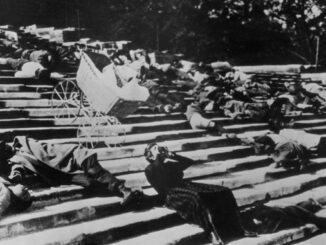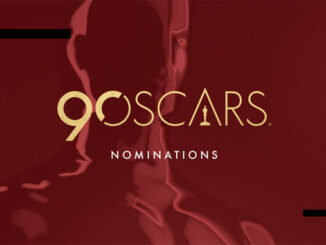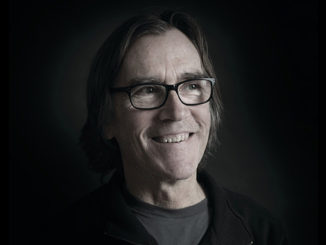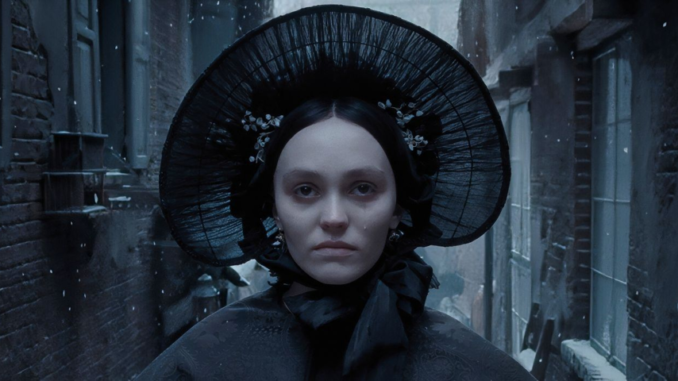
By Patrick Z. McGavin
The creative pairing of the London-born picture editor Louise Ford and the independent filmmaker Robert Eggers has led to some of the most visually distinctive movies in recent American cinema, including the 2019 arthouse hit “The Lighthouse.”
“I feel like even if we weren’t working together, we’d be friends because we share similar interests,” said Ford, who began her career in print journalism. “We bonded over our mutual love of movies.”
Their fourth feature, the hit “Nosferatu,” is a sexually charged retelling of Bram Stoker’s “Dracula,” recast in the form of the vampire Count Orlok (Bill Skarsgård) and his chilling infatuation with the young Ellen Hutter (played by Lily-Rose Depp).
In a recent interview, Ford talked about the evolution of their creative partnership, the principles of picture editing, and how one goes about giving a contemporary sensibility to a Gothic classic.
CineMontage: How would you describe the creative evolution over the four films you’ve made with Robert Eggers?
Louise Ford: Robert and I have been working together for nearly 20 years. We met in 2007, when I cut his short film, “The Tell-Tale Heart”—which was actually the first thing I ever edited. By this point, he’s one of my closest friends; he describes it as a sibling relationship, which is a lovely way to think of it. We bonded over our mutual love of Victorian illustration, Hammer Horror and David Lynch movies.
CineMontage: Is he in the room with you during the edit?
Louise Ford: We’re sort of in constant dialogue, even between projects. He’ll be sending me scripts, so I’m involved, really, from the script stage on his films. I will make suggestions, you know, about how to improve the script. He will be working on that a while before we get greenlit and go into production.
Once I’ve put the assembly together, he will come in every day, and we work through the scenes chronologically, reel-by-reel. He’ll usually have a desk in the edit room and be working on the next script. Wherever we’re cutting, he’ll bring a libraries-worth of books with him for reference. It’s wild—and hard not to be distracted, because they’re often obscure and always super-interesting.
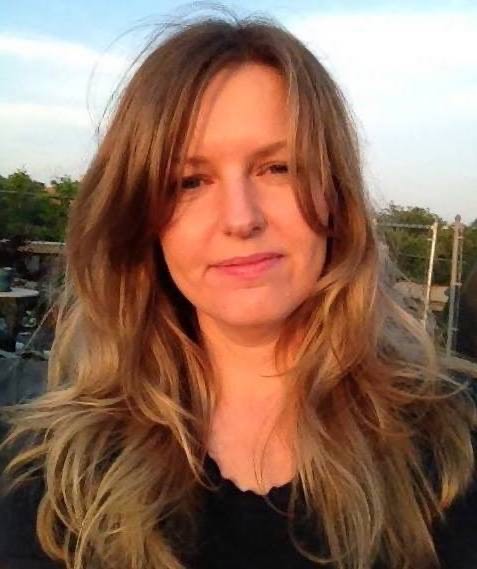
I think with [2015’s] “The Witch,” he wanted to look at every take when we got to a scene. Since then, he trusts my judgment. We’ll only run through the takes for the odd scene or two if there’s a particular thing he remembers, or the original take isn’t working anymore as the scene and film evolves in the edit.
CineMontage: The story of “Nosferatu” has been previously told: F.W. Murnau’s 1922 silent film is considered a landmark in film history, and there’s the 1979 German version by Werner Herzog. How much pressure did you feel to differentiate your film?
Louise Ford: I mean that’s a really great question, and I’m glad I didn’t give it too much thought until right now. Robert has lived with this story and this film since the first time he saw the Murnau original when he was 9-years old. It got its claws into him, so he has been semi-obsessed with it since then. He also knows he’s had his own vision of what he’d wanted to do with that story, which has evolved over the years.
So, I guess I just have so much confidence and faith in Rob as a writer and director, that the history didn’t weigh on me so much. Maybe that was foolish of me? However, I think it starts with the script, and Robert has added some of his own ideas that are not in those films and they’re not even in the source material, Bram Stoker’s “Dracula.”
Robert went back to Stoker’s source material, the historical accounts and folk myths of vampires in that region of Eastern Europe, so his version actually fills in some gaps, some things that have always been puzzling about that story. For instance, why does Hutter (Nicholas Hoult) have to go to Transylvania to meet Orlok when Orlok’s buying a house in Wisburg? There’s a line in this version, in the estate agent’s office where Simon McBurney, Herr Knock, says Orlok is too infirm to travel, and that Orlok insists on seeing an agent “in the flesh,” a little joke for the audience, a nod that we know the story already. It’s just one line of dialogue, but it sort of immediately removes that niggling little point of confusion.
Also, in all the previous incarnations of the Dracula/Nosferatu story, we only hear about the strange Roma customs secondhand from the villagers (in the Murnau film, there is a book at the inn, which Hutter throws aside with dismissive laugh.)
To my knowledge, this is the only version of the story where we actually get to witness the torchlight ceremony, with the virgin on the horse, leading the Roma to the alleged vampire’s grave. It serves as a visual spectacle, but also adds to Hutter’s experience of feeling seduced, and of being a stranger in a strange land. When he wakes in his bed in the morning, he’s not sure whether it was a dream until he sees the mud on his boots. It’s intended to be disorientating for both himself and the audience; a precursor to the more overt disorientations that are to follow.
CineMontage: Gothic can be one of the hardest literary adaptations to capture because the tone is so slippery and elusive. How did you achieve that tone in the editing?
Louise Ford: Robert and I are both steeped in this world. As a child, I was reading ghost stories. I was interested in folk tales and mythology. So I already have a sense of what that atmosphere should feel like. If you think of Henry James’ “The Turn Of The Screw,” Arthur Machen’s “The Great God Pan” or Poe’s “The Fall of the House of Usher,” it’s the characters and atmosphere that stay with you, rather than any details about the plot.
So when you consider all the elements we have at our disposal as filmmakers —images, sound design, music—you would think creating that feeling onscreen might be easier than only having words on a page to work with; so it’s curious that not many films are successful at doing that. Jack Clayton’s “The Innocents” [a 1961 feature based on “The Turn of the Screw”] is the most successful one I can think of, and I know that film is a huge influence on Rob, myself, and our cinematographer, Jarin Blaschke.
CineMontage: Can you think of an example of how editing shapes mood and atmosphere?
Louise Ford: As for creating that atmosphere for “Nosferatu,” I have such ravishing elements to work with in the edit—Rob and Jarin’s very intentional shot designs, Robin Carolan’s haunting score, Craig Lathrop’s astonishing production design, and Linda Muir’s beautiful costumes. It becomes a question of choice, pacing the shots within a sequence, and manipulating the images to make them do what I want them to do, in order to maintain the tension.
For example, when we first meet Orlok, as a tiny figure in the distance when Hutter arrives at the castle, the way it was shot, Orlok quite quickly turns away and starts walking away from us; but I wanted him to just stand there, absolutely still for a few beats—I’m not sure why, I can only say that it felt right or perhaps it lends a certain gravitas, a sense of foreboding or dread.
Anyhow, I manipulated that shot (using Avid effects) to make him stand there, giving us time to go to a medium shot of Hutter looking intimidated, and then bowing, before cutting back to the shot, to have Orlok stand there for another beat, before turning and leaving.
While I was doing my first cut of that sequence, from the moonlit crossroads to the castle stairway, I “scored” it using various drones and tones from Alan Splet’s “Sounds Of A Different Realm,” and “Liminal Void” sound collections, and they were invaluable. And then Damian Volpe gave me a track, “Orlok castle interior” ambience he had designed, which just took it to a whole other level.
CineMontage: Right from the start, the cutting blurs all distinctions between dreams and reality.
Louise Ford: Yes, exactly, that is key. And whenever Robert makes a movie, the studios are always concerned, as they should be, about whether the shots are just too dark for the audience to see what’s going on. But you know, that is part of what feeds into your own imagination as a viewer. You’re watching these kinds of movies, and because you can’t see everything clearly, your imagination goes to town, and that’s one of the reasons they’re so immersive.
I always think, if I’m sitting in a theater, the worst thing is watching a movie where every beat of the story is clearly delineated, and you know exactly what is going to happen next. You’re not being engaged on a subliminal level, you’re not being invited to take part in the storytelling. I think Robert is so successful at doing that, and it’s a combination of pacing and cinematography. It’s also a lot to do with the edit, with the music and the sound effects that all come just together. You should feel pulled into the story as soon as possible.
CineMontage: How conscious were you about modernizing the material to make it more accessible to a contemporary audience?
Louise Ford: I think Robert’s decision to make Ellen (Lily-Rose Depp) the clear protagonist and hero of the story from the beginning, rather than have the “vampire hunters” swing in and save the day at the end (as they do in “Dracula”), hopefully makes it more relevant in 2025. But I know that his decision organically grew out of thinking deeply about the story, rather than a conscious decision to pander. Ellen is the hero in Murnau’s film, but we only find this out at the end—a reflection of the way women were perceived to be less complex and far more passive 100 years ago.
For the editing, it’s the pacing that we have to watch, knowing that a modern audience has far less patience than previous generations, because we are all so much more experienced with watching movies, having become used to instant access via the internet and tablet and phone screens. Both Rob and I are very aware of the fact you have to keep an audience entertained. We were incredibly lucky to have Chris Columbus as a producer and advisor on this film—he was respectful and supportive of Robert, Jarin and I throughout the shooting and editing, but no one knows a modern mainstream audience like Chris, and his notes were invaluable.
Patrick Z. McGavin is a Chicago-based cultural journalist and writer. He writes on film at his Substack, “Shadows and Dreams” (www.patrickzmcgavin.substack.com).


